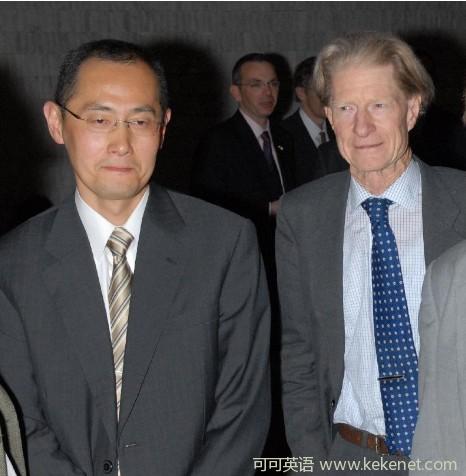
Two stem-cell researchers have won this year's Nobel Prize in Physiology or Medicine for their groundbreaking work in cellular reprogramming, a technique that unleashed a wave of advances in biology, from cloning to the possible treatment of diseases using a patient's own cells.
两位干细胞研究者因其在细胞重新编程方面的开创型工作,获得了今年诺贝尔生理或医学奖。细胞重新编程技术引发了一轮生物学进步浪潮,其中包括克隆以及有可能使用病人自身细胞来治愈疾病。
Experiments by John B. Gurdon of the United Kingdom and Shinya Yamanaka of Japan showed that mature cells taken from the body could be changed to an embryonic-like state in a laboratory dish, a head-spinning discovery that is the biological equivalent of turning back time.
英国人格登(John B. Gurdon)和日本人山中伸弥(Shinya Yamanaka)的试验表明,取自人体的成熟细胞可在实验室培养皿中转变为类似胚胎状态的细胞。这是一项令人震惊的发现,在生物学上相当于将时光倒转。
Their work 'has changed the accepted dogma' that mature cells are condemned to exist in a specialized state, said Martin Evans, a British stem-cell pioneer who shared the 2007 Nobel Prize for medicine, in an interview.
英国干细胞研究先驱、曾于2007年分享诺贝尔医学奖的埃文斯(Martin Evans)在接受采访时说,他们的工作改变了人们认为的成熟细胞只能存活于特定状态下的固有看法。
Cellular reprogramming triggered the rewriting of biology textbooks and spawned thousands of new experiments in labs around the world. It led to the first cloned animal-a frog-and to the first cloned mammal, Dolly the sheep. It also paved the way for deriving embryonic-like stem cells without destroying human embryos, sidestepping an ethically contentious approach.
细胞重新编程引发了生物教科书的改写,在世界各地的试验室里催生了成千上万项新试验。这项技术带来了世界上首只克隆动物──青蛙,进而又出现了首只克隆哺乳动物──绵羊多莉。此外,该技术还为在不破坏人类胚胎的情况下获取类胚胎干细胞铺平了道路,从而避免采用具有伦理争议的干细胞提取方法。
Once cellular reprogramming is used to turn mature cells into embryonic-like ones, those cells can be further manipulated and turned into heart, nerve, muscle and virtually all other tissues types. This freshly made tissue-from an Alzheimer's patient, for example-could be inexpensively grown and studied in a lab dish.
一旦细胞重新编程被用于将成熟细胞转变为类胚胎细胞,这些细胞就可以被进一步培养成心脏、神经、肌肉等几乎一切组织细胞。例如,从患阿尔茨海默病的人身上新获取的组织可在试验室经培养和研究,且花费不多。
Drug firms have already started to test drugs on human tissue made through reprogramming. Next year, fresh retinal cells derived in this way will be transplanted into people for the first time, in a Japanese trial for patients with an eye disease known as macular degeneration.
制药企业已开始对通过重新编程获得的人体组织进行药物试验。明年,用这种方法获得的新生视网膜细胞将首次被移入人体,在日本对患有黄斑病变眼疾的病人进行临床试验治疗。
Scientists used to believe the fate of our cells was a one-way trip. We start as a fertilized egg; become an embryo consisting of immature, undifferentiated cells; then gradually develop into a body of specialist cells, including blood, bone, muscle and skin.
科学家过去认为,细胞的生长是不可逆的。我们始于一个受精卵,然后成为由不成熟、未分化的细胞组成的胚胎,再逐渐发育为由专门细胞构成的个体,包括血液、骨骼、肌肉和皮肤。
In 1962, Dr. Gurdon, while trying to understand how simple, undifferentiated cells became all the other cells in the body, performed an audacious experiment. He removed the DNA from a frog egg and replaced it with the DNA of a mature cell taken from a tadpole. The egg developed into a healthy, cloned tadpole. (The same approach would be used to create Dolly the sheep in 1996.)
1962年,格登还在努力了解未分化的简单细胞是如何变成人体内所有其它细胞的,那时他就做了一项大胆的试验。格登从一枚青蛙卵子中移除DNA,再将从蝌蚪身上提取的成熟细胞的DNA放入这枚卵子内,后来该卵子发育成一只健康的克隆蝌蚪。(1996年克隆羊多莉的诞生也是用的这种方法。)
The frog experiment was an effort to answer 'a pure scientific question about how we came to be formed. There was no foreseeable therapeutic benefit,' said Dr. Gurdon in an interview. Now 79, Dr. Gurdon is a professor at the Gurdon Institute, part of Cambridge University.
格登接受采访时说,那个青蛙试验其实是在努力回答有关我们是如何形成的纯科学问题,当时并没有可预见的治疗益处。如今,79岁的格登是英国剑桥大学(Cambridge University)格登学院(Gurdon Institute)的一名教授。
Dr. Yamanaka, 50, was born in the year Dr. Gurdon did his frog experiment. Dr. Yamanaka would eventually ponder a related question: Could the Gurdon reprogramming trick be done without using eggs-which, in human cases, can be hard to come by?
山中伸弥今年50岁,他出生的那年格登正在做青蛙试验,而他也终将思考一个相关问题:格登的重新编程技术能否在不用卵子的情况下完成?具体到人类试验上,这一点很难做到。
Dr. Yamanaka had the answer a few years later. He demonstrated that by adding just four genes to a mature cell, he could turn it into an embryonic-like state. He first achieved this with mouse cells, and in 2007 he reported the same result for human cells. He transformed those cells, in turn, into heart, nerve and other human tissue in a lab.
山中伸弥在几年后得到了答案。他向世人证明,只需将四个基因引入一个成熟细胞,就可将该细胞转变为类胚胎状态。他首先用老鼠细胞成功做到这一点,然后在2007年又宣布用人类细胞成功完成了这一转变。他将那些细胞在试验室里依次培养为了心脏、神经和其它人类组织细胞。
'Without [Dr. Gurdon's] work we would never have started this risky project 12 years ago,' said Dr. Yamanaka, who is a professor at Kyoto University and affiliated with the Gladstone Institutes in San Francisco, in an interview.
山中伸弥在接受采访时说,没有格登的工作,我们永远不会在12年前着手这项有风险的项目。山中伸弥是日本京都大学(Kyoto University)教授兼美国旧金山格莱斯顿研究院(Gladstone Institutes)高级研究员。













